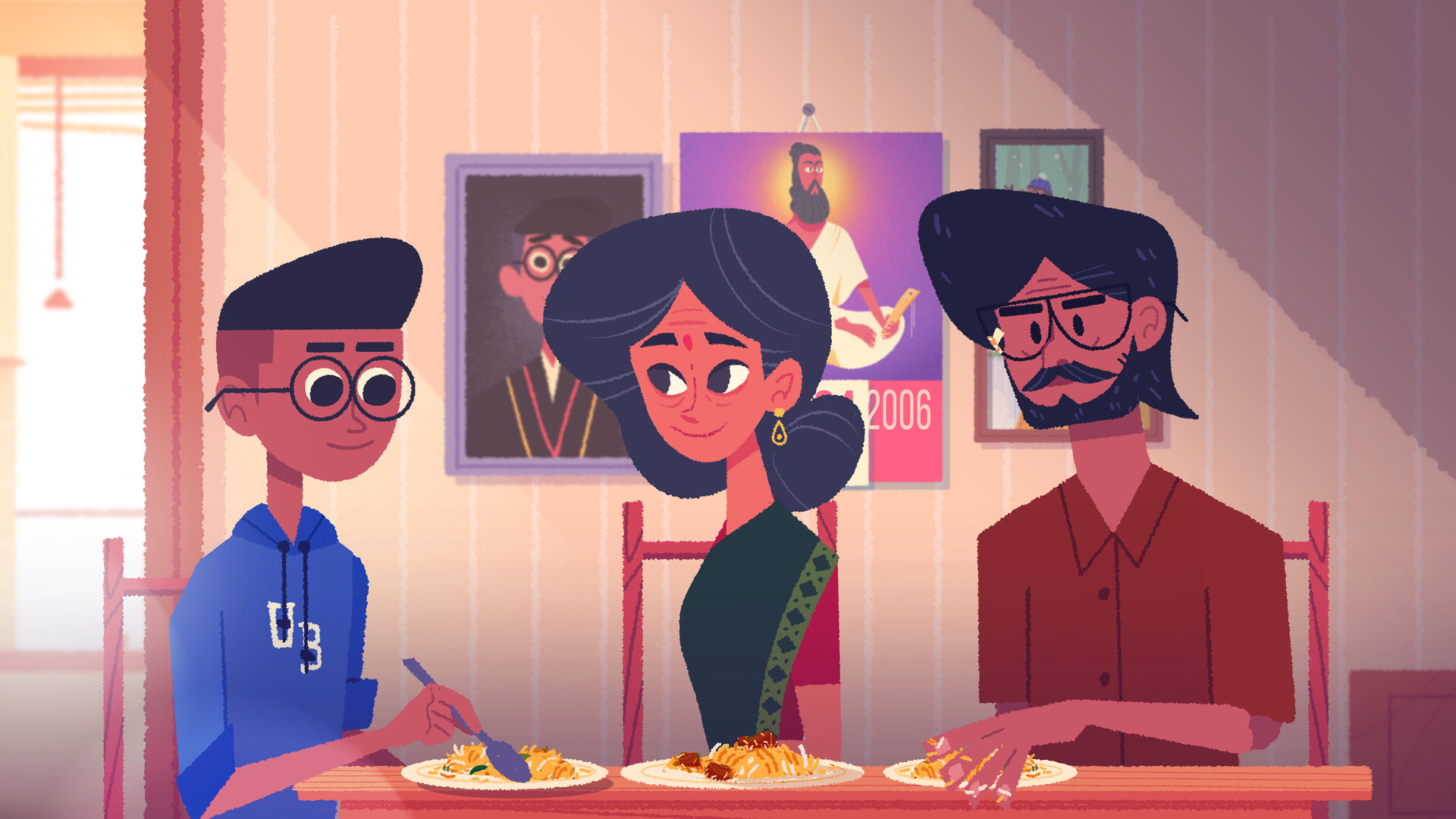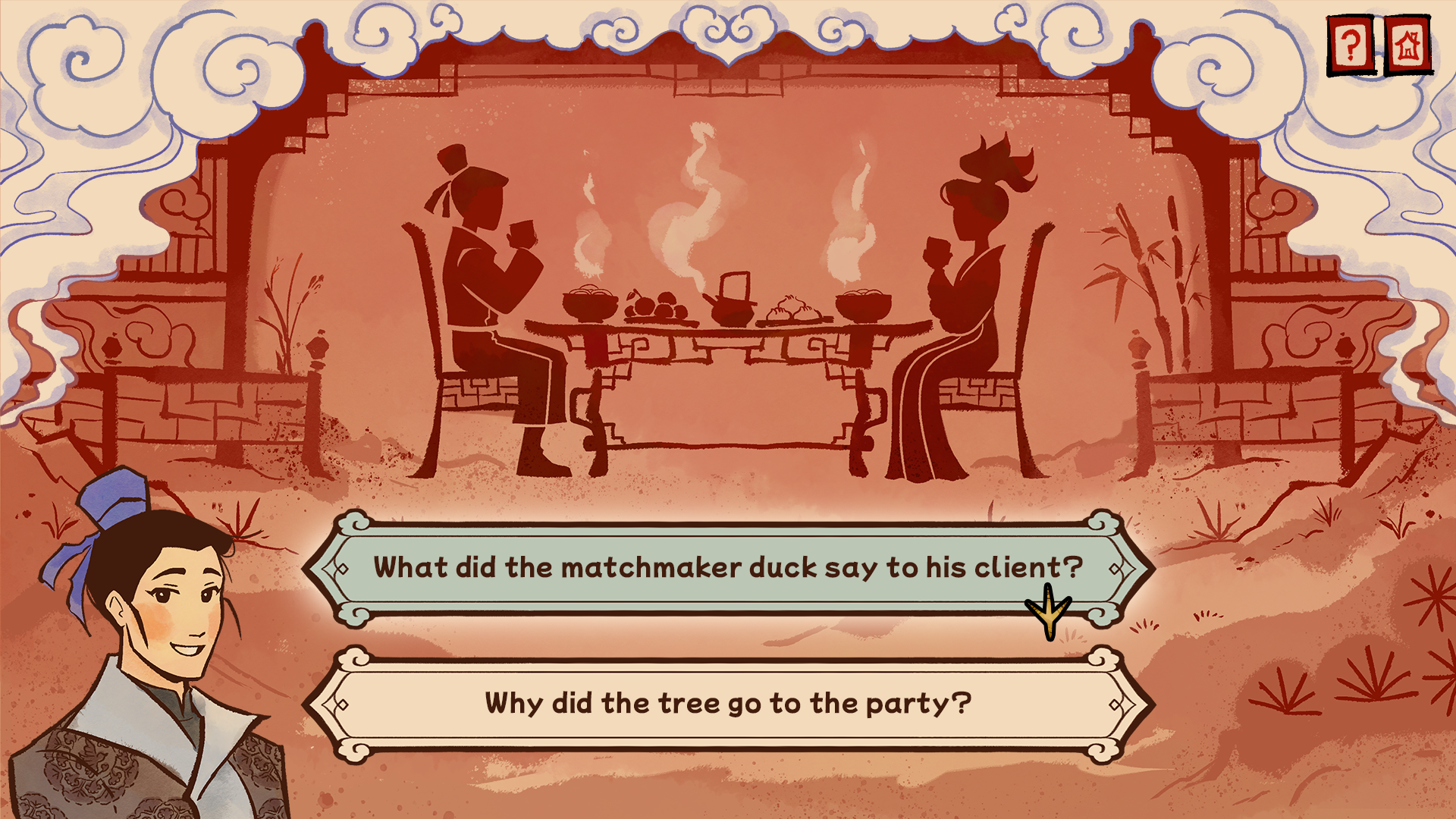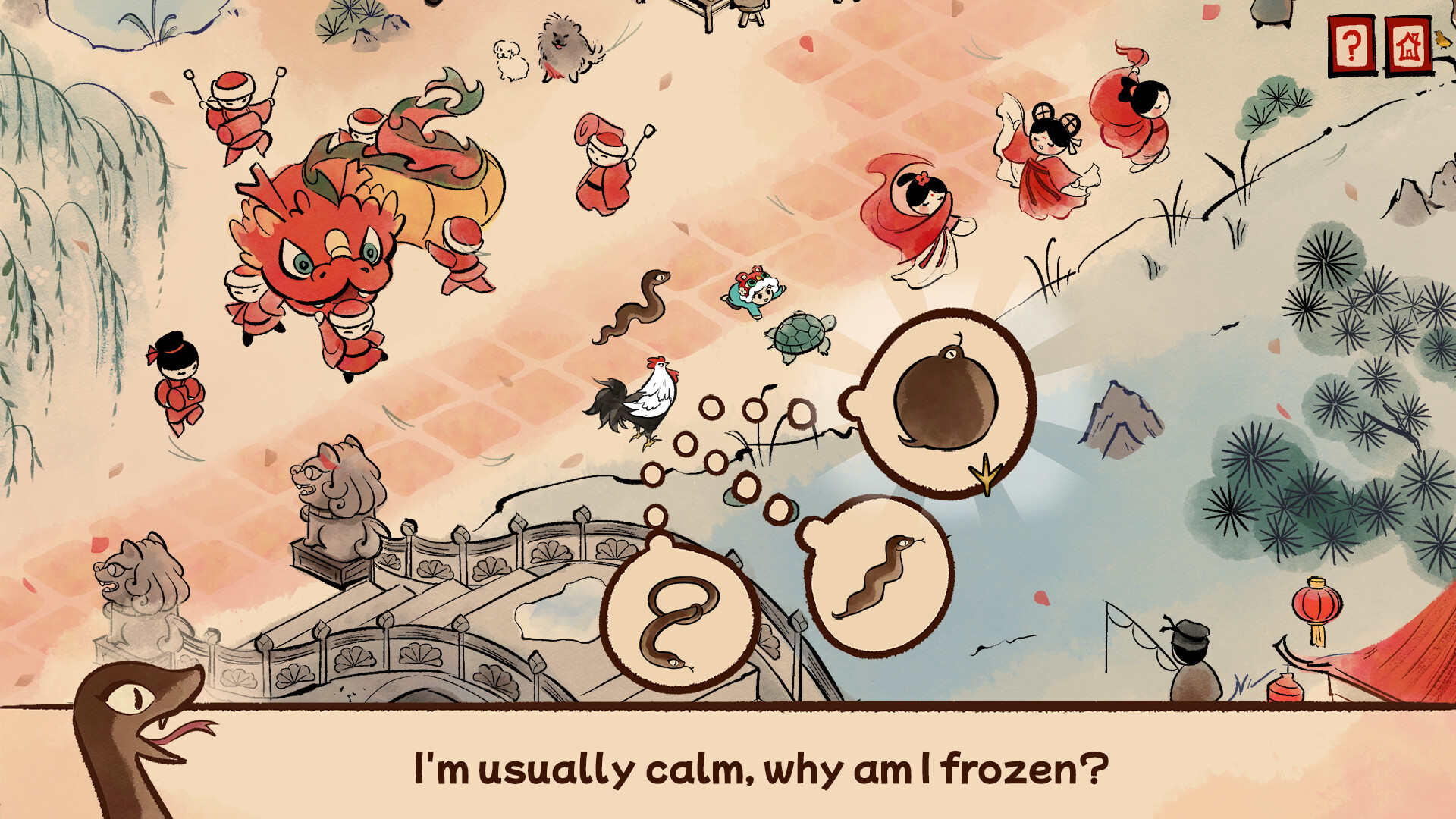
In Ontario’s massive entertainment scene, Sticky Brain Studios is particularly prolific.
Founded by Ted Brunt and Sasha Boersma in 2013, the Toronto-based media company has worked on over 70 games and apps for the likes of Canadian broadcasters, non-profits, government agencies and cultural institutions. This extensive catalogue includes such original properties as the cozy dress-up game Kimono and all-ages puzzler Loki’s Castle and service work on the likes of Game Brain (a primer for teens on the dangers of gambling) and Red Rover (a graphic novel to teach youth about empathy for animals).
A clear throughline in Sticky Brain’s portfolio, then, is a drive to connect with audiences through creative and colourful creations, often in an educational manner. The team’s next game, Rooster, arguably captures that spirit more than anything else.
Inspired by the Chinese Zodiac, the point-and-click puzzle adventure game follows the mischievous titular chicken as he’s sent back to ancient China to learn some life lessons. All of this is depicted through a stunning hand-drawn art style inspired by Chinese brush painting. The concept for Rooster came when Sticky Brain artist Connie Choi was celebrating Lunar New Year with her family, and writer Deborah Chantson was brought on as the narrative designer to help flesh out those ideas.
“I really want people to see the best of Chinese culture. Like, we have a lot of food going on — a lot,” says Chantson with a laugh. “The game is unofficially set in the Tang Dynasty [618–907] but we’re food-agnostic when it comes to eras. I want people to see the joy of the things that we see at museums, like artifacts. There’s a real passion for it that Connie and I have, and Joan [Lee], our animation director, to a certain extent, too.”
Chantson says a recent team trip to the Asian Art Museum in San Francisco while at the Game Developers Conference (GDC) reaffirmed that passion. But she is also aware that many people, especially younger audiences like her kids, won’t go to such a museum, and so she wants to bring that same sort of educational experience into a game like Rooster.
“What I’m really wanting on a personal level is for Rooster to be a love letter to my kids by teaching them about Chinese culture in a gamified way so they can identify their roots later on. I don’t have to be like, ‘Okay, well, this is what you need to do, what’s a good gift, and what’s a bad gift’ — to actually play that instead is more meaningful to them,” she says. “But it’s actually drilled into them now; generally, they won’t open a gift in front of someone. Apparently, Mommy’s taught them well!”
For Chantson, who’s also written for TV and short films, the interactivity afforded by gaming makes it the perfect medium for Rooster.
“I love that the journey will stay with you because it’s like a ‘lean forward’ kind of experience as opposed to a passive thing. But honestly, it’s that Ted and Sasha believed in this project enough to make it what it is,” she says. “Because you can pitch things in TV until you’re blue in the face, but it doesn’t necessarily get to be made, but all the factors have aligned and allowed us the space and the funding and the pathway to be able to do this game. And I love that we’re trailblazing in a way.”
The importance of diversity
Our conversation coincides with Sticky Brain’s first public demo of Rooster at GDC, an industry event at which conversations surrounding diversity were particularly prevalent. In particular, developers have been grappling with an abhorrent harassment campaign against women and minorities in response to a rise in diverse characters in games.
For Boersma, though, Sticky Brain’s backing of a culturally specific experience like Rooster comes down simply to wanting a variety of experiences and supporting the staff who want to make them.
“Ted and I have seen so much — we’ve been around for decades, we’ve seen a lot and we are kind of bored of what we see. And so we’re always looking for something different. How can we make that mechanic more interesting? How can we make this interesting? How is this different?” she says.
“And so when Rooster came along, we just liked it. It was different. And it just felt like the right time. I know myself, I’m neurodivergent. I’m autistic. I never saw myself represented. I’m originally from Sarnia, Ontario. There’s a handful of Canadian literature that even mentions Sarnia. But Southwestern Ontario is not represented in most Canadian media. And I at least have the privilege of being white, but I never saw myself represented, so I can’t imagine if you literally see no one that even looks like you represented.”
She also pushes back against one of the common (and ill-conceived) talking points of detractors of diverse stories: that they’re part of some collaborative push to replace stories featuring white characters.
“It’s one of those things where I think a lot of people when they’re nervous about the diversity, they think it’s some intentional movement. And yes, in some settings, it is. But for us, it was, ‘Wow, Connie, this is a really great game idea, there’s something to this, let’s massage it!’ Why? Because we’ve seen nothing like it out there before.”
And so far, Sticky Brain has already seen that push for representation pay off.
“One of my favorite stories out of GDC is a young student who’s in their third year at NYU. And she apparently had a game idea around Chinese mythology but she was like, ‘Oh, who wants to do that for capstone? No one else has made it so clearly it’s not a good idea.’ Until she walked by and saw our booth and it changed everything for her. And she went, ‘This is my culture, I can see this, I can do this!'” says Boersma. “And she went from in that few moments of turning the corner went from, ‘Oh, I really want to do this but it’s clearly never been done, so why would I do it?’ to seeing this booth and seeing these other female professionals of East Asian ethnicity and suddenly going, ‘Wait, my idea does have legs, I can do this!'”
What an exciting and heartwarming experience to see people play and enjoy Rooster at GDC. We are thankful for everyone that visited our booth and everyone that participated in making this event a success.
Be sure to wishlist ROOSTER on Steam right now. Link in bio.
#GDC2024 pic.twitter.com/KonjGDbcWv— Sticky Brain Studios (@gumsmarts) April 2, 2024
Sticky Brain points to last year’s massively popular Venba from fellow Toronto studio Visai Games as a testament to the resonance that diverse stories can have in games. The viral cooking game follows an Indian mother in Toronto as she tries to connect with her son through Tamil food.
“We just haven’t seen in the Western world a cooking game rooted in Tamil food and culture. For our team, even though no one on our team is Tamil, we really hold that game close because it’s different,” says Boersma. “And again, it’s not like anyone intentionally went ‘We need more Indian games.’ They just wanted to make a game that represented their culture. And it was the same thing with Rooster.”
Chantson notes that having a diverse team only helped Rooster better represent Chinese culture.
“I think we’re all bringing something to it. And it’s nice because we’re all a different kind of Asian so it’s a big mix of like, ‘Okay, let’s put this in,’ and we go, ‘Oh, okay, that’s cool.’ And then it’s also like a pre-vetting for like, ‘Oh, okay, is this too specific to one particular dialect or something?” she says.
Something that also further differentiates Rooster from Venba is its focus on 12 different minigames set across a dozen chapters inspired by the Chinese Zodiac. Only one of those is centred around cooking, while others involve tower defence, garden design and even dating sims.
While that might sound like a lot, Boersma and Chantson note that each minigame has been designed to be easy to pick up and play even for casual audiences, with the pair specifically aiming to appeal to fans of the so-called “cozy” genre.
“It’s not that Rooster is that technically complex, either, because even though they’re different mechanics. It’s not like we’re pushing those mechanics that far. So it’s heavy on art and animation and wanting it to look right and feel right and all that finessing,” she said.
Boersma adds that while she loves a lot of cozy games, they often have “the exact same mechanic over and over,” which encouraged Sticky Brain to pursue more variety in Rooster. While she acknowledges that it can understandably be expensive for smaller teams to develop multiple kinds of minigames, she credits Canadian funding opportunities for offering Sticky Brain more freedom.
“We can do that thanks to the Canada Media Fund and Ontario Creates — that we’re not beholden to what a publisher says we can give,” she says. “We can try something differently, which is what CMF has called the envelope innovation. We’re innovating in a way that no publisher would ever give us funding to be able to try.”
Access to greater resources also helps Sticky Brain pursue another passion: accessibility. As Boersma explains, about half of the team is neurodivergent, encouraging the studio to adopt a “system of flexibility” to accommodate workers with different needs.
“I know that in Canada, we’re very careful about our hiring processes and we’re really worried about the right fit. And that’s an issue, but we really feel like you [need to] get to the essence of ‘What do we need this person to do?’ and the skills, both hard skills and soft skills, and really hone your interview practices on determining those skills and that person’s ability to handle those skills,” she says. Through that, Sticky Brain has been able to welcome a diversity of employees, including those with disabilities and from different racial backgrounds.
“And when you start doing that a couple of times, then other people start to see it, and they start to go, ‘Oh, hey, I’ve got this really cool young person of colour who just needs a chance, can you meet with them?'” she explains. “Once you start on this path, people see you for who you are. A lot of our people are people with disabilities and the referrals are coming in. ‘Okay, I’ve got someone who would be great, but they need a company who’s going to understand how they work their hours.'”
That consideration of accessibility extends to Rooster itself. Boersma notes that the development team was trained by the disability charity group AbleGamers to make Rooster more accessible. This helped the team incorporate accessible design practices early on, which experts say is essential for meaningful accessibility.
“It’s in our wireframes. We have cards marked out for ‘What do we need that’s specific to this level that are accessibility requirements?’ How do we do this where more people can play?’ We’re talking about levels with hidden object gameplay? And, and it’s like, ‘If you couldn’t do this, what would you need?'” says Chantson. “And so those are part of our regular conversations, which is nice. We’re talking about hints and at what point the timer gets slowed down, if you weren’t going to read the text, is it going to be voiced and that sort of thing? These are part of our regular conversations. Working at another company for eight years, we never had these conversations.”
“The Return on Disability Group has done many studies to show the economic impact of people with disabilities and so it economically makes sense because it can unlock additional players to this game,” adds Boersma. “These are things that we need in our games, we know that there’s an economical sense for this, we know that video games have not traditionally done a good job of it, and so why not do it?”
But of course, Sticky Brain aims to appeal to all kinds of players, not just those who are Chinese or have disabilities. To that point, Chantson echoes a saying that many people, including Venba creator Abhi, have expressed: “The more specific your story, the more universal its appeal.” In structuring Rooster around the titular character’s life milestones, Chanston hopes to touch players from all backgrounds, including through a section that was inspired by the deaths of her mother and grandparents. She also teases a monkey level that she hopes will be particularly moving.
“I want people to engage emotionally and come away with something that they feel has been a journey for them. Games give you all the escapism and the fantasy and I want you to have an experience with this and to come away feeling like, ‘Okay, that was worth my time, my money, my effort, and I can see the effort that the team put into it,'” she says.
“Because even from the [GDC] booth, people are like, ‘Wow, there’s a lot of passion in it.’ And explaining the little things like in the snake level, our pets are featured, and my boys are the two little dancing figures with fireworks. But the sound effect is my youngest son when he’s a baby and my dad’s like dropping a sock on him and he’s giggling. It’s those little things that I want people to pick up on like, ‘Okay, that comes from somewhere.’
This interview has been edited for language and clarity.
Rooster is targeting a January 2025 launch on PC. You can wishlist the game on Steam.
Image credit: Sticky Brain Studios
MobileSyrup may earn a commission from purchases made via our links, which helps fund the journalism we provide free on our website. These links do not influence our editorial content. Support us here.








